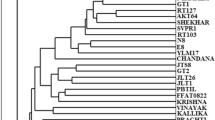Abstract
By federal law in Mexico, A. tequilana Weber var. Azul is the only variety of agave permitted for the production of any tequila. Our objective was to assay levels of genetic variation in field populations of A. tequilana var. Azul using randomly amplified polymorphic DNA (RAPD) markers. Ten plants were collected from each of four different fields, with two fields being located in each of two principal regions of Mexico for the cultivation of A. tequilana var. Azul. The two regions are separated geographically by approximately 100km. Genetic relationships between A. tequilana var. Azul and two other varieties of A. tequilana Weber, ‘Chato’ and ‘Siguin’, were also investigated using RAPDs. Among the three varieties, 19 decamer primers produced 130 markers, of which 20 (15.4%) were polymorphic betweenA. tequilana var. Chato and A. tequilana var. Siguin. The results of RAPD analysis suggest that A. tequilana var. Siguin is more closely related to A. tequilana var. Azul than is A. tequilana var. Chato. Among the 40 field selections of A. tequilana var. Azul, only 1 of124 RAPD products (0.8%) was polymorphic and 39 of 40 plants were completely isogenic. This is one of the lowest levels of polymorphism detected to date for the analysis of a crop species, and is proposed to be the result of the promotion of a single conserved genotype over many years due to an exclusive reliance on vegetative propagation for the production of new planting materials. The significance of these results is discussed in relation to breeding programs focused on the improvement of A. tequilana var. Azul.
Similar content being viewed by others
References
Al-Zahim, M., H.J. Newbury & B.V. Ford-Lloyd, 1997. Classification of genetic variation ingarlic (Allium sativum L.) revealed by RAPD. HortScience 32: 1102–1104.
Avise, J.C., 1994. MolecularMarkers, Natural History and Evolution. Chapman & Hall, Inc. New York.
Bolger D.J. & B.B. Simpson, 1995.A chloroplast DNA study of the Agavaceae. Systematic Botany 20: 191–205.
Bolger, D.J. & B.B. Simpson,1996. Phylogeny of Agavaceae based on its ITS rDNA sequence variation. Am J Bot 83: 1225–1235.
Colunga-GarcíaMarín, P., J. Coello-Coello, L.E. Eguiarte & D. Piñero, 1999. Isozymatic variation and phylogeneticrelationships between heneqÚen (Agave fourcroydes) and its wild ancestor A. angustifolia (Agavaceae). Am J Bot 86: 115–123.
Degani, C., L.J. Rowland, A. Levi, J.A. Hortynski & G.J. Galletta, 1998. DNA fingerprinting ofstrawberry (FragariaXananassa) cultivars using randomly amplified polymorphic DNA (RAPD) markers. Euphytica 102: 247–253.
Diario Oficial de la Federación, 1993. FSecretaria de Comercio y Fomento Industrial. Norma OficialMexicana NOM-006-SCFI-1993. Bebidas Alcohólicas-Tequila-Especificaciones. Mexico, D.F. October 13. pp. 48–52.
Doyle, J.J. & J.L. Doyle, 1989. Isolation of plant DNA from fresh tissue. Focus 12: 13–15.
Eguiarte, L.E., M.V. Duvall, G.H. Learn & M.T. Clegg, 1994. The systematic status of the Agavaceae and Nolinaceae and related Asparagales in the Monocotyledons: An analysis of the rbcL gene sequence. Boletín de la Sociedad Botánica de Mexíco 54: 35–56.
Felsenstein, J., 1985. Confidence limits on phylogenies: an approach using thebootstrap. Evolution 39: 783–791.
Gentry, H.S., 1982. Agaves of Continental North America. TheUniversity of Arizona Press. Tucson, AZ.
Martínez-Palacios, A., L.E. Eguiarte & G.R. Furnier, 1999. Geneticdiversity of the endangered endemic Agave victoriae-reginae (Agavaceae) in the Chihuahuan desert. Am J Bot 86: 1093–1098.
Massey, L.K. & J.L. Hamrick, 1998. Genetic diversity and population structure of Yucca filamentosa(Agavaceae). Am J Bot 85: 340–345.
Massey, L.K. & J.L. Hamrick, 1999. Breeding structure of aYucca filamentosa (Agavaceae) population. Evolution 53: 1293–1298.
Nair, N.V., S. Nair, T.V. Sreenivasan & M. Mohan, 1999. Analysis of genetic diversity and phylogeny in Saccharum and related genera using RAPD markers. Genet Res Crop Evol 46: 73–79.
Nobel, P.S., 1994. Remarkable Agaves and cacti. Oxford Univ.Press, Oxford.
Palacios, C. & F. Gonzalez-Candelas, 1997. Lack of genetic variability in the rare and endangeredLimonium cavanillesii (Plumbaginaceae) using RAPD markers. Mol Ecol 6: 671–675.
Ramírez, M.P. & A. López, 1985. Investigación sobre la utilización de fibra de agave en el estado de Oaxaca. Plan de Desarrollo Agroindustrial del Agave en el Estado de Oaxaca. Inst. Tec. de Oaxaca.
Skroch, P., J. Tivang & J. Nienhuis, 1992.Analysis of genetic relationships using RAPD marker data. In: Applications of RAPD technology to plant breeding. Joint Plant Breeding Symposia Series. Crop Sciences Society of America, Madison, WI.
S-Plus Users Guide Version 4.0. MathSoft, Inc. Seattle, WA.
This, P., C. Cuisset & J.M. Boursiquot, 1997. Development of stable RAPD markers for theidentification of grape rootstocks and the analysis of genetic relationships. Am J Enol Vitic 48: 492–501.
Trame, A.M., A.J. Coddington & K.N. Paige, 1995. Field and genetic studies testing optimal outcrossing in Agaveschotti, a long-lived clonal plant. Oecologia 104: 93–100.
Valenzuela, A.G., 1997. El agave tequilero: sucultivo e industria. 2nd. Ed. Monsanto Press, St. Louis.
Williams, J.G.K., A.R. Kubelik, K.J. Livak, J.A. Rafalski & S.V. Tingley, 1990. DNA polymorphisms amplified by arbitrary primers are useful as genetic markers. Nuc Acids Res 18: 6531–6535.
Author information
Authors and Affiliations
Rights and permissions
About this article
Cite this article
Gil Vega, K., González Chavira, M., Martínez de la Vega, O. et al. Analysis of genetic diversity in Agave tequilana var. Azul using RAPD markers. Euphytica 119, 335–341 (2001). https://doi.org/10.1023/A:1017553107303
Issue Date:
DOI: https://doi.org/10.1023/A:1017553107303



